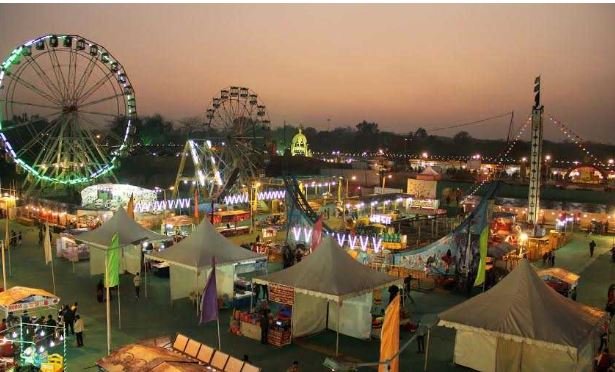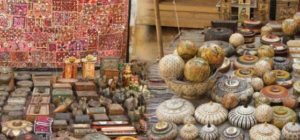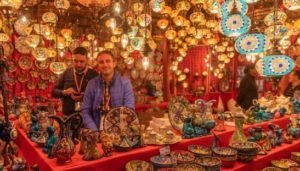Surajkund Mela:” International Art, Crafts & Cuisine Fair”


Surajkund meaning the “Lake of the Sun”, holds immense historical significance. The mela (fair in English) got its name from Surajkund Lake which was an ancient reservoir constructed by King Suraj Pal of the Tomar dynasty in the 10th century.
Surajkund Mela was held for the first time in 1987 which takes place in February every year. The main purpose was to boost tourism in Haryana state by showcasing the richness and diversity of the handicrafts, handlooms, and the cultural heritage of Haryana.

Surajkund Mela is organized by the Surajkund Mela Authority & Haryana Tourism in collaboration with the Union Ministries of Tourism, Textiles, Culture, and External Affairs.
Since the start of the Surajkund fair began, all the states of India have been participating in the fair. Generally, one state chooses to be the Theme State.
In 2013, the Surajkund fair was upgraded to an international level and was rechristened as “28th Surajkund International Crafts Mela”.
In 2014, over 15 countries from European & African continents participated in the Mela including SAARC nations.
However, in 2015, a record number of 20 countries participated in the Mela and Lebanon was the Partner Nation and state of Chhattisgarh, the Theme State.
In 2024, Nearly 40 countries including “Tanzania” took part in the Mela, and people got a glimpse of African culture in the stalls put up by other nations from the continent.
And, all eight states from the northeast i.e., Arunachal Pradesh, Assam, Manipur, Meghalaya, Mizoram, Nagaland, Sikkim, and Tripura participated as cultural partners.
A splash of colors, rhythm of drum beats, and joy de-vivre merge at Surajkund in Faridabad, Haryana during the first fortnight of each February. The curtains go up on the acclaimed annual Surajkund International Crafts Mela from 1st February onwards, a celebration of Indian folk traditions and cultural heritage.

Surajkund Mela draws crowds to experience global diversity and celebrates rich cultural tapestry, arts, handicrafts, cuisines, etc. Occupying a place of pride on the international tourist calendar, more than a million visitors throng the Mela during the fortnight including hundreds of thousands of foreign tourists.
Surajkund Mela is unique as it showcases the richness and diversity of the handicrafts, handlooms, and cultural fabric of India, & is the largest crafts fair in the world. The Mela celebrates the unique diversity of Indian traditions and culture in an ambience, created to represent the ethos of rural India.
Surajkund Mela has designated places for amusement, adventure sports, and joy rides to make it a must-visit event for the young.
Surajkund International Crafts Mela showcases some of the most exquisite handlooms and handicrafts in India. Handmade fabrics soaked in ethnic colors make an eye-catching display for visitors.
Mela witnessed a heavy turnout of visitors as they had a lot of choices to shop handicrafts, witness cultural performances, exhibition and relish an array of cuisine
A large number of renowned national and international folk artistes and cultural groups present day performances at both the Chaupals, and the open-air theatres, located in the Mela premises.
Also, enthralling cultural evening programmers are held at the main Chaupal during each of the Mela evenings. The Mela is indeed a custodian of heritage crafts involving the use of traditional skills that are fading away due to cheap machine-made imitations, and a special section is earmarked for showcasing these heritage crafts.

Lots of thrilling experience visitor experiences for example, at the fair’s Virasat Cultural Exhibition, the stall welcomes the visitors with “Pagdi Bandhao, Photo Khinchao” (Get turban tied and click a picture) as they happily wear the ‘Haryanvi Pagdi’ and click photos.
Iron, brass, and wooden bells used for cows, buffaloes, elephants, and carts are also displayed at the mela.
At the exhibition, wooden blocks used for printing, and the measurement scales used in rural areas for measuring grains and oil in the pre-Independence era, are also on display.
Art and crafts cut across borders and build bridges of understanding are being proved in this mela.
The multi-cuisine Food Court provides ethnic cuisines from all over the world, which are immensely popular with visitors.
DISCLAIMER: The author is solely responsible for the views expressed in this article. The author carries the responsibility for citing and/or licensing of images utilized within the text.
